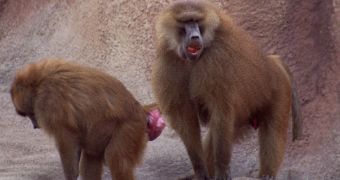Ancient Egyptians venerated baboons, and regarded them as gods. In some cultures, the word "baboon" can be a derogatory term for "ugly man". But baboons are considered the primates that are closely related to us in their stress inducing environment. Stress researcher Robert Sapolsky believes they are so similar to humans because they have almost no natural predators and hence the majority of their stress derives from their social functioning. From his researches made on Kenyan baboons, we deduce 10 similarities between humans and our distant cousin.
1. Low hierarchy individuals suffer of the most elevated levels of physical and psychological stress, manifested by high blood pressure, suppression of immune system, and high levels of the stress hormones (like cortisol). Does this remind you of the new young workmate?
2. It is also important for the baboons to make the difference between a real menace (like a rival defying it) and a neutral factor (like one baboon sleeping on an upper branch). Those that see all situations as possible dangers and threats finish by getting ill. Such is the case of neurotic people, isn't it? Controlling the violence means less stress and better health.
3. The most sociable baboons are the most healthy and the ones with the lowest stress levels. Sociability means better health for baboons and humans too. Since their birth, baboons build up social and affective links, which are strong and long-lasting.
4. Baboons have a powerful tendency towards aggression and competition.
5. These primates have the tendency to take different decisions depending on whether they think emotionally or rationally. The humans differ only in the fact that they can extend all beyond the immediate situation and environment. We can be aggressive or altruist to somebody on the other edge of the planet.
6. Baboons manifest friendship, envy, wickedness.
7. Each individual develops his own unique personality, based on its own genetics and early personal history and infancy.
8. Baboons have a way of thinking, and a particular behavior; they commit much more errors if decisions are made on instincts. But they find it hard to control themselves and postpone the reward. This human ability could be linked to the higher development of the frontal cortex, the brain region involved in the autocontrol. Even if baboons think and decide, they act in a uninhibited and unwary manner.
9. Baboons can make the difference between different people. They recognize Maasai people from the others, due to their red clothing. They dread the Maasai, as their dogs hunt the baboons and some Maasai children use the baboons as target for practicing spear throwing.
10. Baboons make politics. Hierarchy is established by power, size and sharpness of the fangs, weight, muscle mass, but also by aggressiveness, the ability to form alliances, or to know when to stab a companion from behind. Except the fangs, the other issues seem familiar... The factors are determined by biology (like the fangs or the size), others by the environment and personality.

 14 DAY TRIAL //
14 DAY TRIAL //